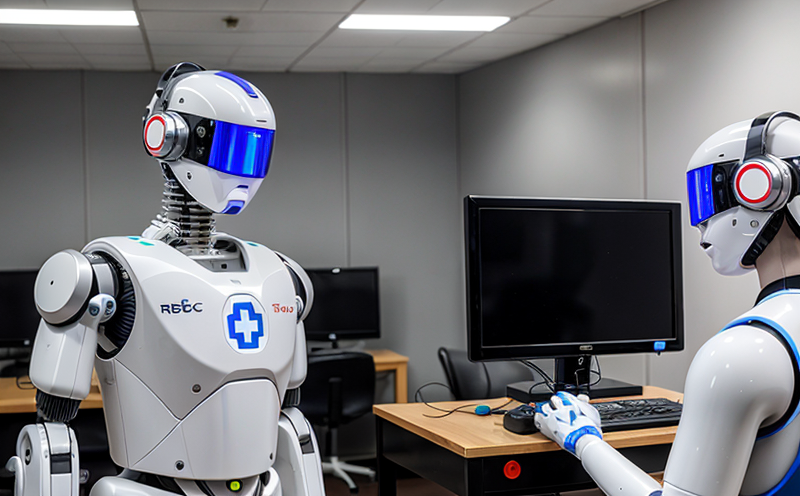ISO 14971 Risk Management Validation for Medical Robots
The International Organization for Standardization (ISO) 14971 standard provides a framework for the application of risk management to medical devices, ensuring they are safe and effective. In the context of medical robots, this standard is crucial as it helps in identifying potential risks associated with these complex systems and implementing measures to mitigate them effectively.
Risk management involves several steps including hazard identification, risk analysis, risk evaluation, and risk control. ISO 14971 integrates these into a comprehensive process that is designed to ensure medical robots meet the highest safety standards before they are used in clinical settings. This standard applies equally well to surgical robots, rehabilitation devices, assistive technology, and other advanced robotic systems employed in healthcare.
For quality managers, compliance officers, R&D engineers, and procurement professionals involved in robotics and AI development for medical applications, this service is essential. It ensures that the products they bring to market are not only innovative but also safe and reliable, aligning with international best practices and regulatory requirements.
The validation process under ISO 14971 involves a series of detailed steps aimed at identifying all potential risks associated with medical robots, evaluating their impact on patient safety, and implementing necessary controls. This includes thorough documentation that can be used during audits or when responding to regulatory inquiries.
By adhering to the principles outlined in ISO 14971, manufacturers can demonstrate due diligence and reduce liability exposure. Additionally, compliance with this standard enhances the reputation of companies involved in medical robotics by signaling their commitment to quality and safety standards recognized globally.
This service is particularly valuable for firms looking to enter regulated markets such as Europe or North America where stringent regulatory requirements exist. It ensures that all products meet not only functional but also safety criteria, thereby facilitating smoother market entry processes.
In summary, ISO 14971 risk management validation provides a structured approach to ensuring the safety and effectiveness of medical robots. This method helps companies navigate complex regulatory landscapes while maintaining high standards of product quality and patient care.
Scope and Methodology
The scope of ISO 14971 risk management validation for medical robots encompasses the entire lifecycle of these devices from design through production to post-market surveillance. The methodology involves several key steps:
Hazard Identification: This begins with an exhaustive examination of all possible hazards that could arise during various stages of a robot's operation. Hazards are categorized based on their severity and likelihood, providing a structured way to prioritize them.
Risk Analysis: Once identified, each hazard is analyzed using quantitative or qualitative methods to determine its potential impact on patient safety. This analysis often involves simulations, modeling techniques, and expert reviews.
Risk Evaluation: Based on the results of risk analysis, risks are evaluated against acceptable levels defined by regulatory bodies like the FDA or EMA. Any risks exceeding these thresholds must be mitigated through appropriate actions.
Risk Control: Measures to reduce identified risks include design changes, additional safeguards, training programs for operators and users, and enhanced monitoring systems. All control measures are documented thoroughly in compliance with ISO 14971 requirements.
The validation process also includes regular reviews during the product lifecycle, ensuring ongoing compliance with current standards and addressing any emerging issues promptly.
Competitive Advantage and Market Impact
Adopting ISO 14971 risk management validation offers significant competitive advantages for companies in the medical robotics sector. By demonstrating a commitment to rigorous safety standards, firms can:
- Earn Trust: Establish trust with regulatory authorities and healthcare providers who rely on reliable data.
- Increase Compliance: Ensure full compliance with international regulations like those set by the FDA or EMA.
- Enhance Reputation: Boost brand reputation among consumers who prioritize safety in medical devices.
- Facilitate Market Access: Open up access to key markets where stringent regulatory requirements apply.
In terms of market impact, adherence to ISO 14971 helps companies stay ahead of competitors by ensuring they meet the most current safety standards. This can lead to increased sales and better positioning in competitive landscapes.
Moreover, this service supports continuous improvement initiatives within organizations, fostering a culture of excellence that extends beyond regulatory compliance into product innovation and patient care.
Use Cases and Application Examples
| Use Case | Description |
|---|---|
| Surgical Robots | Risk management ensures that surgical robots operate safely, minimizing the risk of complications during procedures. |
| Rehabilitation Devices | Evaluating risks in rehabilitation devices helps optimize patient outcomes by reducing potential adverse effects. |
| Assistive Technology | Validation processes identify and mitigate risks associated with assistive technologies used by individuals with disabilities. |
| Robotic Prosthetics | Risk management plays a crucial role in ensuring the safety of robotic prosthetics, enhancing user experience and reliability. |
| Telemedicine Robots | Identifying risks associated with telemedicine robots helps ensure secure remote consultations and accurate data transmission. |
| Maintenance Drones | Evaluating safety in maintenance drones ensures that they perform critical tasks without posing threats to personnel or infrastructure. |
| Automated Lab Assistants | Risk management helps automate lab assistants operate safely, minimizing human errors and ensuring accurate results. |
The above table illustrates various use cases where ISO 14971 risk management validation is particularly beneficial. Each of these applications highlights the importance of thorough risk assessment and mitigation strategies in ensuring that medical robots perform reliably and safely.





